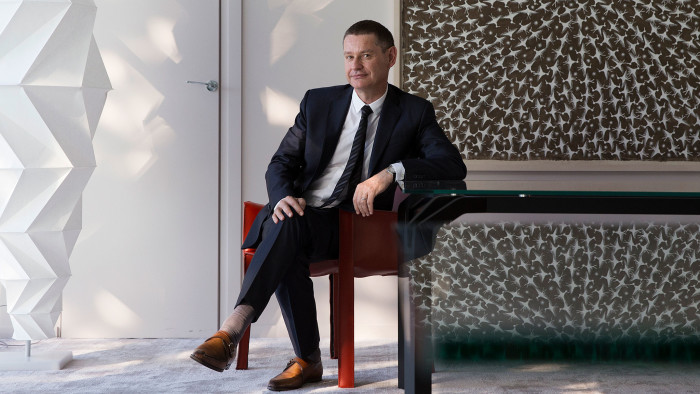Cyrille Vigneron returns to Cartier to clean house

Roula Khalaf, Editor of the FT, selects her favourite stories in this weekly newsletter.
“Twenty-seven cities, I guess, 15 countries and three continents,” says Cyrille Vigneron, new chief executive of Cartier, totting up where his job has taken him since he started in January. He needs to visit foreign offices and outlets “because the world seen from Paris, or from Geneva, can be a bit too Eurocentric. Europe might be in the centre of our concerns,” he says, alluding to the UK’s vote to leave the EU, “but many things are moving in the rest of the world.”
Mr Vigneron is talking in his large, sparsely furnished Parisian office with its commanding view over the courtyard of “Fortress Cartier”, the office complex the size of a city block which rises behind the fashionable Rue du Faubourg Saint-Honoré. He was appointed by parent company Richemont to replace Stanislas de Quercize, who stood down for health reasons after less than two years in the job.
One of his first moves, industry rumours said, was to buy back a considerable stock of unsold watches; a sum of €200m-€250m was mentioned. He declines to confirm or deny this, but does say: “We have to support our partners, and if at some point something is not working, we have to co-manage things so that we have the right offer and the right place. If they don’t want to keep it and if they send it somewhere else, it means problems in another region. So you have to be much more reactive, and work much more closely with all the parties.”
One of the problems Mr Vigneron alludes to is that unsold watches get moved on to the “grey market”, where they are sold outside the intended region through unauthorised shops and websites at significant discounts. Retailers do this to recoup some of their outlay, but manufacturers dislike it because it harms their brand by undercutting regular sales through well-managed channels.
The cause may lie with the creator as well as the vendor or economic conditions, he says. If a product is not working, the manufacturer has a responsibility “to reduce your production, to reduce your offer”, he argues. “The world is too fast now. So when you realise you’re wrong, or it’s not working as you want, you have to take the hit faster.”
With something of the air of the cleverest boy in the class, Cyrille Vigneron has been a Cartier lifer since he joined in the late 1980s. He worked his way up: managing director of Cartier Japan (1997-2002), president of Richemont Japan (2002-2005) and managing director of Cartier Europe (2005-13). He stepped outside the Richemont circle in 2014, to become president of LVMH Japan, part of a rival conglomerate, but he is back and he has moved decisively with his mission to improve the fortunes of the house.
Cartier is central to Richemont, which includes brands such as IWC Schaffhausen, Panerai and Jaeger-LeCoultre. The jewellery division, comprising Cartier, Van Cleef & Arpels and start-up Giampiero Bodino, accounted for more than €6bn of Richemont’s total sales of €11.1bn in the 2015-16 financial year. By comparison, Richemont’s specialist watchmakers together had sales of €3.2bn.
Cartier’s jewellery is not a problem — he talks of “double-digit growth” — but watches are trickier. There was a time when Cartier had big horological hits: Pasha and Tank Americaine in the 1980s and Tank Française in the 1990s were successes. But Cartier has not had that sort of success since the Ballon Bleu launched in 2007. “I think we can make a smash hit again,” he says confidently, but he admits that work remains, demanding a retreat to core principles. “We have done too many things, in too many directions, which makes it confused as to what Cartier stands for.”
In his mind, however, there is no confusion: “Cartier stands for a shaped watch, simple design . . . and not too [many] complications.” He does say that after six months in the market, the initial signs are that Drive, the cushion-cased watch, has been well received.
Clinging to the core does not involve trying to emulate the Apple Watch. “Do we have to do connected watches or not?” he asks. “I think we should not, because we have a promise of durability, and [the connected watch] is the promise of obsolescence.”
Cartier will need to change some of its store locations, he says. “You have to know when something doesn’t make sense any more. In a city where there has been a lot of boom that then gets more quiet, you have to reduce your presence, so probably we have to reduce our presence in Hong Kong.”
Nevertheless, Mr Vigneron continues to believe that in the long term China offers great potential for Cartier and, by extension, for the rest of the Richemont group.
“I think the current trend’s perspective looks better for jewellery than for watches, but watches still have a bright future. The growth rate of the coming years might not be as massive as it has been, but it is still there. Does Cartier have potential for growth? Yes. And would other Richemont brands also have potential for growth? Yes.”
But can they grow without cannibalising each other? The answer is also yes, he argues, provided “each has a good concept.” Of course, in his mind a good concept is a core concept — and that is what he is teasing out of Cartier.
Comments